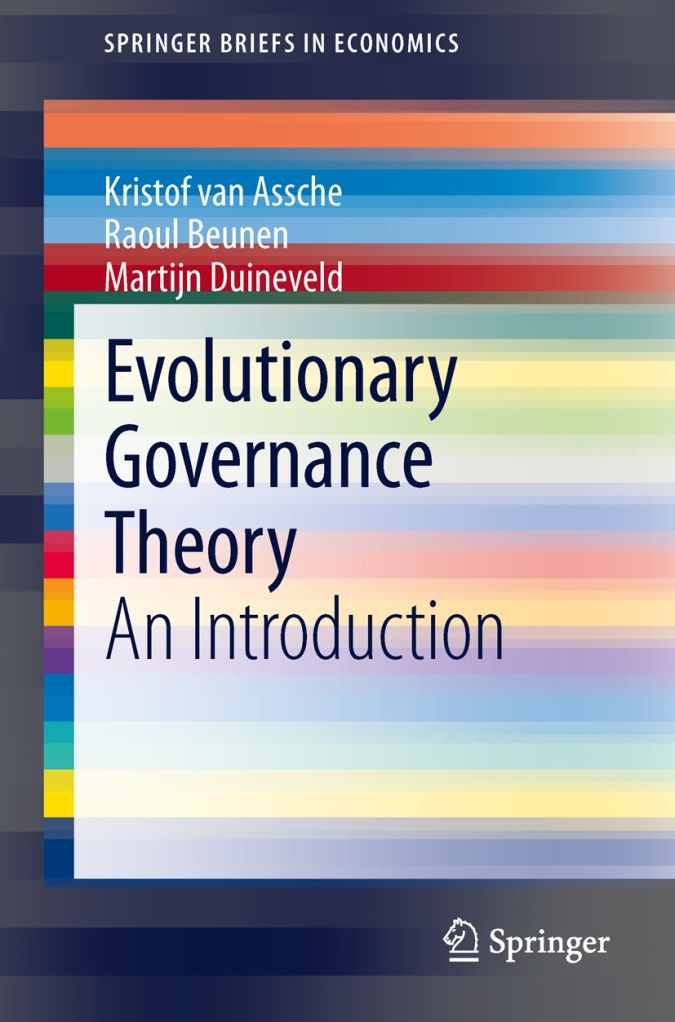Evolutionary Governance Theory (EGT) is a novel perspective on the way markets, laws and societies evolve together. It can be of use to anyone interested in development, markets, public sector reform, public administration, politics and law. Drawing on a wide range of case studies on three continents and a variety of conceptual sources, the authors have developed a theory that clarifies the nature and functioning of dependencies that mark governance evolutions. EGT delineates in an entirely new manner the spaces open for policy experiment. As such, it offers a new mapping of the middle ground between libertarianism and social engineering. Theoretically, the approach draws on a wide array of sources: institutional and development economics, social systems theories, post-structuralism, actor- network theories, planning theory and legal studies.
On this website you can find more information about EGT and the different concepts as well as an overview of articles that present empirical studies and theoretical reflections on various governance issues. Enjoy reading! More information and publications can also be found on the website of the Center for Open Science https://osf.io/3njkt/
The book Evolutionary Governance Theory: an introduction is published by Springer. It can be downloaded from their website.
It is also possible to download the different chapters separately. Many university libraries offer access to the full texts. Here you can find a brief overview of the book and its different chapters.
1. Introduction
[download]
Abstract: In this chapter we outline the main theoretical sources of EGT- social systems theory, new institutional economics, development economics, and post- structuralism in different versions [download].
Abstract: In this chapter we present some foundational concepts of EGT. We elaborate on functional and organisational differentiation and on formal, informal and dead institutions. The way these two sets of concepts are combined, forms the basis of the perspective on governance paths [download].
Abstract: In this chapter we discuss the concept of governance paths and the forms of dependency marking paths. The forms of dependency constitute rigidities in governance evolution, but leave space for flexibility, for path creation [download].
5. Seeing, making & distributing things
Abstract: In this chapter we investigate the construction of subjects and objects in governance paths, the inclusion of those in policies and plans, and their impact via implementation. Implementation is understood as a process, and policies are considered temporary constructs coordinating power/knowledge, but continuously affected by other power/knowledge configurations [download].
Abstract: In this chapter we discuss a special form of discursive structure, narrative, and its effects. Metaphors and open concepts are analysed as concepts that have effects amplified in narratives. These effects can vary from closing the narrative to opening it, from linking by suggesting similarity to disconnecting by suggesting dissimilarity. Ideologies are then presented as embedding narratives [download].
7. Governance paths and reality effects
Abstract: In this chapter we investigate the reality effects of discourses in governance and discourses codified in policy. We distinguish between performance and performativity and acknowledge the importance of the discursive context. Next we discuss the performance and performativity exemplified by two special types of narratives, those claiming success and failure. The impact of narratives of success and failure on governance paths is examined [download].
8. Governance and its categories
Abstract: In this chapter we elaborate on the situation after evolution and present a framework to analyse a world in which many governance paths have produced a wide variety of governance arrangements. Understanding the functioning of governance arrangements requires reconstruction of paths. Such reconstruction can be aided by a categorization of the resulting arrangements. We propose two ways to categorize, one for the larger scale, distinguishing governance models, and one for the smaller scale, distinguishing governance dimensions [download].
Abstract: In this chapter we bring together a series of the concepts presented earlier in a brief synthesis of EGT. Actor/institution and power/knowledge configurations are presented as the fundamental concepts shaping the development of governance paths [download].
10. Policy formulation & EGT: making governance work
Abstract: In this chapter we briefly outline a number of domains of application for EGT, some preliminary insights in each domain, and methodological considerations. We conclude with a reflection on the value of EGT in mapping out the middle ground between libertarian and socialist ideologies [download].

Leave a comment